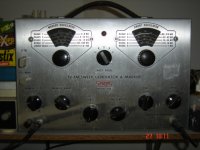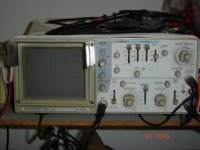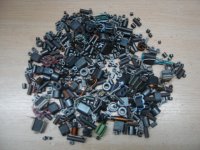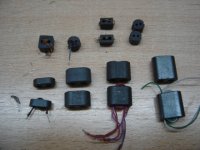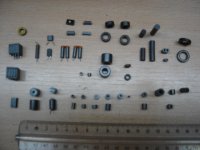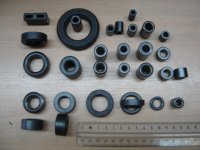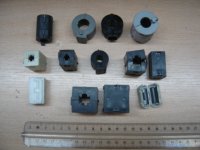Let me suppose that I find a ferrite core behind a tree, and it is entire, not broken. Then, I will not know at which frequency is best to use it. Then, is there any easy way to measure its properties?
I know how to measure the hysteresis loop using an oscilloscope and a generator, but try to measure it at, say 100MHz is not so easy than at 1MHz.
Is any way to recognize it by the color, for example, or by the granule sizes, or the part bright, appearance, etc.?
Many thanks in advance. Best regards.
I know how to measure the hysteresis loop using an oscilloscope and a generator, but try to measure it at, say 100MHz is not so easy than at 1MHz.
Is any way to recognize it by the color, for example, or by the granule sizes, or the part bright, appearance, etc.?
Many thanks in advance. Best regards.
Toroid or other shapes ? Toroids seem to have a standard colour coding. Check:
https://www.google.co.in/search?q=c...r6xtXPAhVGOo8KHZJcA5kQsAQIHA&biw=1400&bih=768
https://www.google.co.in/search?q=c...r6xtXPAhVGOo8KHZJcA5kQsAQIHA&biw=1400&bih=768
Is any way to recognize it by the color, for example, or by the granule sizes, or the part bright, appearance, etc.
To the trained eye, it is possible to broadly identify the category of ferrite by its visual appearance, but within limits: for example, I would be unable to distinguish a N27 grade from a N41, but I could recognize which is which if I had 3D4 and 4C6 materials in front of me.
It is difficult to transfer that kind of knowledge with words, but I will try.
Common ferrites come mainly in two varieties: NiZn, and MnZn.
NiZn have a lowish permeability, low saturation limit, but relatively good RF properties. Typical application include two-hole shapes, RF screw cores etc.
MnZn have a high permeability, a high saturation limit, but their losses increase quickly with frequency, and they are used in power chokes, SMPS Xformers, etc..
The first thing to notice is that Ni ferrites have a high resistivity: to the common ohmmeter, they look like insulators, but Mn ferrites will show a resistance of a few kΩ if you press the tips of an ohmmeter against them.
They also look different: Ni ones look finer, smoother, and may have a shade of violet. By contrast, Mn tend to be darker, coarser, and small crystals are generally visible in the structure.
Within the two categories, the ones that show the most pronounced of those features are the more typical of their categories.
For Ni ones, the very low permeability types (relatively easy to measure) are VHF or UHF types.
For the Mn, those having a very low resistivity are very high permeability/high loss types, like T38.
For more detailed information, a jig like the one shown here (pics 2 and 3) is invaluable: it lets you know the saturation characteristics, and is particularly helpful for Mn (power) ferrites
I wonder if such a jig can be implemented in higher frequencies. I need to tests dozen's of ferrite cores, including double aperture binocular (balun) cores, ferrite beads (single hole, SMD and double cores), and VK200 cores. I need them in an FM tuner front end I'm working in, using 2 tubes, and I will need it for decoupling EBB's and heater's. But how to know if these cores can do the job. Next week I will post photos of such cores.
I wonder if such a jig can be implemented in higher frequencies. I need to tests dozen's of ferrite cores, including double aperture binocular (balun) cores, ferrite beads (single hole, SMD and double cores), and VK200 cores. I need them in an FM tuner front end I'm working in, using 2 tubes, and I will need it for decoupling EBB's and heater's. But how to know if these cores can do the job. Next week I will post photos of such cores.
You can measure these high frequency impedance using a spectrum analyzer with synchronized generator working as wideband network analyzer, for instance the Rigol SA
Jim Brown (EMI/RFI expert) has several papers that deal with ferrites. But I don't recall any about identifying unmarked ferrites.
http://www.audiosystemsgroup.com/publish.htm
**************************
Unless you have a large quantity, wouldn't it be simpler to buy the correct ones?
http://www.audiosystemsgroup.com/publish.htm
**************************
Unless you have a large quantity, wouldn't it be simpler to buy the correct ones?
Last edited:
Jim Brown (EMI/RFI expert) has several papers that deal with ferrites. But I don't recall any about identifying unmarked ferrites.
Audio Systems Group, Inc. Publications
**************************
Unless you have a large quantity, wouldn't it be simpler to buy the correct ones?
You make me laugh. Here in Argentina, buy a ferrite, with known parameters? Don't joke to me! As I still could't buy the two Terman books, and that they come to my house. And, yes, I have a large can with recovered ferrite pieces. Next week I'll post a photo. Some of them are very strange.
You can measure these high frequency impedance using a spectrum analyzer with synchronized generator working as wideband network analyzer, for instance the Rigol SA
Unfortunately, my only instruments available are a 40MHz oscillo and a legendary Eico 368 sweep generator, completely restored.
Attachments
At somewhat higher frequencies, yes, very much higher would be complicated (I never use the word impossible), and anyway, you don't need to know the saturation limit of Ni ferrites at high frequencies, because it is essentially the same as for low frequencies, and if you attempted to actually operate such a ferrite near its saturation limit at RF, like in a transmitter for example, it would melt down in a matter of seconds.I wonder if such a jig can be implemented in higher frequencies. I need to tests dozen's of ferrite cores, including double aperture binocular (balun) cores, ferrite beads (single hole, SMD and double cores), and VK200 cores. I need them in an FM tuner front end I'm working in, using 2 tubes, and I will need it for decoupling EBB's and heater's. But how to know if these cores can do the job. Next week I will post photos of such cores.
The saturation value is useful though, because these ferrites are often used as cores for chokes, and need to pass a significant DC current without saturating.
An emblematic example of such an application is the legendary VK200, based on 5 hole group 4 ferrite (although higher permeability group 3 clones have also been produced, but they lack the VHF/UHF properties of the original)
Note that because group 4 ferrites (Ni types) have a low permeability, they benefit from a sort of inherent protection against saturation, even though their nominal saturation limit is lower than for Mn types: the number of A.t required to reach saturation is very high, even for closed (gapless) shapes.
If you use Ni types (which are easy to distinguish as a group) for your heaters, I wouldn't be too worried: they should withstand the LF current without problems or loss of properties.
Regarding general properties, you can go a long way using your instruments: with some additional jigs, you can measure permeability and losses at least.
Note that all I said applies to the most common ferrites: other types can be encountered, baryum or other elements for special applications, and even group 4 ferrites can be deliberately contaminated with iron ions to increase their permeability (to the expense of all other parameters, of course).
It is common practice in many materials of US origin: RF transformers in HP or Tek gear often fall into that category.
Others are optimized for mechanical resistance, like drum cores for example, and tend to have hybrid properties too: some attributes of Ni, especially resilience, and a relatively high permeabilty and a moderate to high saturation limit.
Modern materials now tend to blur the lines: some Ni ferrites can work for high saturation/high power applications, and some Mn ferrites venture into the RF /VHF domain
Sorry, I didn't think about the problems of importing small parts.You make me laugh. Here in Argentina, buy a ferrite, with known parameters? Don't joke to me!
Not exactly the measurements you want, but start at about page 31.
"A Ham's Guide to RFI, Ferrites, Baluns, and Audio Interfacing"
Revision 5a 5 Jun 2010
by Jim Brown K9YC
Audio Systems Group, Inc.
Audio Systems Group, Inc. Home Page
http://www.audiosystemsgroup.com/RFI-Ham.pdf
"A Ham's Guide to RFI, Ferrites, Baluns, and Audio Interfacing"
Revision 5a 5 Jun 2010
by Jim Brown K9YC
Audio Systems Group, Inc.
Audio Systems Group, Inc. Home Page
http://www.audiosystemsgroup.com/RFI-Ham.pdf
There are only so many manufacturers, so you can collect catalogs to get material types. The color coded toroids are pretty easy, but they're not as standard as you might hope. What I do is wrap N turns on the part and measure the inductance. The geometry is usually easy to measure. Then you can calculate the Al and look through the parts catalogs to see what likely candidates are.
Many thanks for all the inputs. I'll do some tests the next weekend, and take a photo of the ferrite cores stock. For instance, I have a cube with 8 holes where 4 wires can pass go and back. This, when mounted in a PCB can make a single winding 4 turn coil, a double 2T or a 4 1T coils. Very strange, and, obvious to say, ferrite material is an unknown.
Also, I have some slugs of material, that appears to "cabonous", like a DC motor brush, but it is not conductive.
Also, I have some slugs of material, that appears to "cabonous", like a DC motor brush, but it is not conductive.
Sorry, I didn't think about the problems of importing small parts.
Kevin, the problem is that it is not difficult import small pieces, here it is all difficult.
Our politics are a pest.
Not exactly the measurements you want, but start at about page 31.
"A Ham's Guide to RFI, Ferrites, Baluns, and Audio Interfacing"
Revision 5a 5 Jun 2010
by Jim Brown K9YC
Audio Systems Group, Inc.
Audio Systems Group, Inc. Home Page
http://www.audiosystemsgroup.com/RFI-Ham.pdf
Many thanks. I downloaded this stuff, and this weekend I'll print and read patiently.
Thanks again.
- Status
- This old topic is closed. If you want to reopen this topic, contact a moderator using the "Report Post" button.
- Home
- Design & Build
- Parts
- Ferrites
